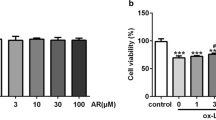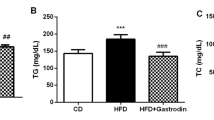Abstract
Macrophage-derived foam cells are well known for their key role in development of atherosclerosis (AS). The present study aimed to examine whether dioscin exerts anti-atherosclerotic activity and inhibits foam cell formation. A high-fat induced AS model and ox-LDL treated macrophages were established and received treatment of dioscin. Anti-atherosclerotic activity in vivo was assessed by atherosclerotic lesions size and aortic lipid contents. Macrophage formed foam cells were positively identified by oil red o staining. Moreover, the expression of LOX-1 and NF-κB in aorta tissue and macrophages was examined by western blotting assay. Our results showed that dioscin not only reduced the levels of plasma lipid, TNF-a, IL-1β and IL-6, but also inhibited atherosclerotic development in AS rats, as evidenced by decreased atherosclerotic lesions size and aortic lipid level. In vitro study revealed dioscin directly reduced foam cell formation, decreased intracellular cholesterol accumulation and lowered TNF-a, IL-1β and IL-6 secretion in ox-LDL treated macrophages. Interestingly, further work found dioscin significantly reduced expression of LOX-1 and NF-κB in the aortic tissue and ox-LDL treated macrophages. In summary, our study was the first to confirm anti-atherosclerotic activity of dioscin in vivo and vitro. Moreover, the other important finding is dioscin mediated ox-LDL/LOX-1/NF-κB regulated contributions to the attenuate macrophage ox-LDL uptake and AS.






Similar content being viewed by others
References
Aluganti Narasimhulu C, Fernandez-Ruiz I, Selvarajan K, Jiang X, Sengupta B, Riad A, Parthasarathy S (2016) Atherosclerosis—do we know enough already to prevent it? Curr Opin Pharmacol 27:92–102
Bhaskar V, Yin J, Mirza AM, Phan D, Vanegas S, Issafras H, Michelson K, Hunter JJ, Kantak SS (2011) Monoclonal antibodies targeting IL-1 beta reduce biomarkers of atherosclerosis in vitro and inhibit atherosclerotic plaque formation in Apolipoprotein E-deficient mice. Atherosclerosis 216:313–320
Chase AJ, Bond M, Crook MF, Newby AC (2002) Role of nuclear factor-kappa B activation in metalloproteinase-1, -3, and -9 secretion by human macrophages in vitro and rabbit foam cells produced in vivo. Arterioscler Thromb Vasc Biol 22:765–771
Deepa PR, Varalakshmi P (2005) Atheroprotective effect of exogenous heparin-derivative treatment on the aortic disturbances and lipoprotein oxidation in hypercholesterolemic diet fed rats. Clin Chim Acta 355:119–130
Feng J, Gao J, Li Y, Yang Y, Dang L, Ye Y, Deng J, Li A (2014) BMP4 enhances foam cell formation by BMPR-2/Smad1/5/8 signaling. Int J Mol Sci 15:5536–5552
Glass CK, Witztum JL (2001) Atherosclerosis. the road ahead. Cell 104:503–516
Goyal T, Mitra S, Khaidakov M, Wang X, Singla S, Ding Z, Liu S, Mehta JL (2012) Current Concepts of the Role of Oxidized LDL Receptors in Atherosclerosis. Curr Atheroscler Rep. 2012 Jan 29. [Epub ahead of print] PMID: 22286193
Hashizume M, Mihara M (2012) Atherogenic effects of TNF-α and IL-6 via up-regulation of scavenger receptors. Cytokine 58:424–430
Kanters E, Pasparakis M, Gijbels MJ et al (2003) Inhibition of NF-kappaB activation in macrophages increases atherosclerosis in LDL receptor-deficient mice. J Clin Invest 112:1176–1185
Kanters E, Gijbels MJ, van der Made I, Vergouwe MN, Heeringa P, Kraal G, Hofker MH, de Winther MP (2004) Hematopoietic NF-kappaB1 deficiency results in small atherosclerotic lesions with an inflammatory phenotype. Blood 103:934–940
Kataoka H, Kume N, Miyamoto S et al (1999) Expression of lectinlike oxidized low-density lipoprotein receptor-1 in human atherosclerotic lesions. Circulation 99:3110–3117
Li L, Sawamura T, Renier G (2004) Glucose enhances human macrophage LOX-1 expression: role for LOX-1 in glucose-induced macrophage foam cell formation. Circ Res 94:892–901
Li K, Tang Y, Fawcett JP, Gu J, Zhong D (2005) Characterization of the pharmacokinetics of dioscin in rat. Steroids 70:525–530
Li HQ, Zhang Q, Chen L et al (2015) Captopril inhibits maturation of dendritic cells and maintains their tolerogenic property in atherosclerotic rats. Int Immunopharmacol 28:715–723
Lin YW, Liu PS, Adhikari N, Hall JL, Wei LN (2015) RIP140 contributes to foam cell formation and atherosclerosis by regulating cholesterol homeostasis in macrophages. J Mol Cell Cardiol 79:287–294
Liu M, Xu L, Yin L et al (2015a) Potent effects of dioscin against obesity in mice. Sci Rep 5:7973
Liu M, Xu Y, Han X et al (2015b) Dioscin alleviates alcoholic liver fibrosis by attenuating hepatic stellate cell activation via the TLR4/MyD88/NF-κB signaling pathway. Sci Rep 5:18038
Lu X (2016) Impact of macrophages in atherosclerosis. Curr Med Chem 23:1926–1937
Lu B, Xu Y, Xu L, Cong X, Yin L, Li H, Peng J (2012) Mechanism investigation of dioscin against CCl4-induced acute liver damage in mice. Environ Toxicol Pharmacol 34:127–135
Ma M, Song L, Yan H et al (2016) Low dose tunicamycin enhances atherosclerotic plaque stability by inducing autophagy. Biochem Pharmacol 100:51–60
Martín-Fuentes P, Civeira F, Recalde D, García-Otín AL, Jarauta E, Marzo I, Cenarro A (2007) Individual variation of scavenger receptor expression in human macrophages with oxidized low-density lipoprotein is associated with a differential inflammatory response. J Immunol 179:3242–3248
Mehta JL, Sanada N, Hu CP et al (2007) Deletion of LOX-1 reduces atherogenesis in LDLR knockout mice fed high cholesterol diet. Circ Res 100:1634–1642
Moore KJ, Tabas I (2011) Macrophages in the pathogenesis of atherosclerosis. Cell 145:341–355
Murawska-Cialowicz E, Januszewska L, Zuwala-Jagiello J et al (2008) Melatonin decreases homocysteine level in blood of rats. J Physiol Pharmacol 59:717–729
Noa M, Mas R (2005) Protective effect of policosanol on atherosclerotic plaque on aortas in monkeys. Arch Med Res 36:441–447
Pamukcu B, Lip GY, Shantsila E (2011) The nuclear factor–kappa B pathway in atherosclerosis: a potential therapeutic target for atherothrombotic vascular disease. Thromb Res 128:117–123
Pan CH, Tsai CH, Liu FC, Fan MJ, Sheu MJ, Hsieh WT, Wu CH (2013) Influence of different particle processing on hypocholesterolemic and antiatherogenic activities of yam (Dioscorea pseudojaponica) in cholesterol-fed rabbit model. J Sci Food Agric 93:1278–1283
Panel AP (2006) Reducing residual cardiovascular risk: the relevance of raising high-density lipoprotein cholesterol in patients on cholesterol-lowering treatment. Diabetes Vasc Dis Resn 3:S1–S12
Papa S, Bubici C, Zazzeroni F, Franzoso G (2009) Mechanisms of liver disease: cross-talk between the NF-kappaB and JNK pathways. Biol Chem 390:965–976
Pirillo A, Norata GD, Catapano AL (2013) LOX-1, OxLDL, and atherosclerosis. Mediators Inflamm 2013:152786
Poudel B, Lim SW, Ki HH, Nepali S, Lee YM, Kim DK (2014) Dioscin inhibits adipogenesis through the AMPK/MAPK pathway in 3T3-L1 cells and modulates fat accumulation in obese mice. Int J Mol Med 34:1401–1408
Qi M, Zheng L, Qi Y et al (2015) Dioscin attenuates renal ischemia/reperfusion injury by inhibiting the TLR4/MyD88 signaling pathway via up-regulation of HSP70. Pharmacol Res 100:341–352
Qu X, Zhai Z, Liu X et al (2014) Dioscin inhibits osteoclast differentiation and bone resorption though down-regulating the Akt signaling cascades. Biochem Biophys Res Commun 443:658–665
Robbesyn F, Salvayre R, Negre-Salvayre A (2004) Dual role of oxidized LDL on the NF-kappaB signaling pathway. Free Radic Res 38:541–551
Rodríguez C, Alcudia JF, Martínez-González J, Raposo B, Navarro MA, Badimon L (2008) Lysyl oxidase (LOX) down-regulation by TNFalpha: a new mechanism underlying TNFalpha-induced endothelial dysfunction. Atherosclerosis 196:558–564
Scott J (2004) Pathophysiology and biochemistry of cardiovascular disease. Curr Opin Genet Dev 14:271–279
Shapiro MD, Fazio S (2016) From lipids to inflammation: new approaches to reducing atherosclerotic risk. Circ Res 118:732–749
Shepherd J, Cobbe SM, Ford I et al; West of Scotland Coronary Prevention Study Group (2004) Prevention of coronary heart disease with pravastatin in men with hypercholesterolemia, 1995. Atheroscler Suppl 5:91–97
Tao X, Wan X, Xu Y et al (2014) Dioscin attenuates hepatic ischemia-reperfusion injury in rats through inhibition of oxidative-nitrative stress, inflammation and apoptosis. Transplantation 98:604–611
Tao X, Sun X, Yin L et al (2015) Dioscin ameliorates cerebral ischemia/reperfusion injury through the downregulation of TLR4 signaling via HMGB-1 inhibition. Free Radic Biol Med 84:103–115
van der Vorst EP, Döring Y, Weber C (2015) Chemokines and their receptors in Atherosclerosis. J Mol Med (Berl) 93:963–971
Wang L, Meng Q, Wang C et al (2013) Dioscin restores the activity of the anticancer agent adriamycin in multidrug-resistant human leukemia K562/adriamycin cells by down- regulating MDR1 via a mechanism involving NF-κB signaling inhibition. J Nat Prod 76:909–914
Wang H, Liu Y, Zhu L et al (2014) 17β-estradiol promotes cholesterol efflux from vascular smooth muscle cells through a liver X receptor α-dependent pathway. Int J Mol Med 33:550–558
White SJ, Sala-Newby GB, Newby AC (2011) Overexpression of scavenger receptor LOX-1 in endothelial cells promotes atherogenesis in the ApoE(-/-) mouse model. Cardiovasc Pathol 20:369–373
Wong MC, de Zhang X, Wang HH (2015) Rapid emergence of atherosclerosis in Asia: a systematic review of coronary atherosclerotic heart disease epidemiology and implications for prevention and control strategies. Curr Opin Lipidol 26:257–269
Wu S, Xu H, Peng J, Wang C, Jin Y, Liu K, Sun H, Qin J (2015) Potent anti-inflammatory effect of dioscin mediated by suppression of TNF-α-induced VCAM-1, ICAM-1and EL expression via the NF-κB pathway. Biochimie 110:62–72
Xia X, Li Y, Su Q, Huang Z, Shen Y, Li W, Yu C (2015) Inhibitory effects of Mycoepoxydiene on macrophage foam cell formation and atherosclerosis in ApoE-deficient mice. Cell Biosci 5:23
Xu S, Ogura S, Chen J, Little PJ, Moss J, Liu P (2013) LOX-1 in atherosclerosis: biological functions and pharmacological modifiers. Cell Mol Life Sci 70:2859–2872
Xu T, Zheng L, Xu L, Yin L, Qi Y, Xu Y, Han X, Peng J (2014a) Protective effects of dioscin against alcohol-induced liver injury. Arch Toxicol 88:739–753
Xu Y, Kong X, Zhou H, Zhang X, Liu J, Yan J, Xie H, Xie Y (2014b) oxLDL/β2GPI/anti-β2GPI complex induced macrophage differentiation to foam cell involving TLR4/NF-kappa B signal transduction pathway. Thromb Res 134:384–392
Yang RX, Huang SY, Yan FF, Lu XT, Xing YF, Liu Y, Liu YF, Zhao YX (2010) Danshensu protects vascular endothelia in a rat model of hyperhomocysteinemia. Acta Pharmacol Sin 31:1395–1400
Zhang M, Wu JF, Chen WJ et al (2014) MicroRNA- 27a/b regulates cellular cholesterol efflux, influx and esterification/hydrolysis in THP-1 macrophages. Atherosclerosis 234:54–64
Zhang N, Lei J, Lei H, Ruan X, Liu Q, Chen Y, Huang W (2015) MicroRNA-101 overexpression by IL-6 and TNF-α inhibits cholesterol efflux by suppressing ATP-binding cassette transporter A1 expression. Exp Cell Res 336:33–42
Zhao X, Xu L, Zheng L, Yin L, Qi Y, Han X, Xu Y, Peng J (2016) Potent effects of dioscin against gastric cancer in vitro and in vivo. Phytomedicine 23:274–282
Zhou F, Pan Y, Huang Z, Jia Y, Zhao X, Chen Y, Diao J, Wan Q, Cui X (2013) Visfatin induces cholesterol accumulation in macrophages through up-regulation of scavenger receptor-A and CD36. Cell Stress Chaperones 18:643–652
Acknowledgements
This work was supported by Anhui Provincial Natural Science Foundation under Grant (No. 1408085MH167); and Anhui Provincial science and technology key project under Grant (No. 1301042094).
Author information
Authors and Affiliations
Corresponding authors
Ethics declarations
Disclosure of interest
The authors declare that they have no conflict of interest.
Research involving animals
Animal experiments were conducted in accordance with ethical standards laid down in the 1964 Declaration of Helsinki and its later amendments for the care and use of animals.
Rights and permissions
About this article
Cite this article
Wang, P., He, Ly., Shen, Gd. et al. Inhibitory effects of Dioscin on atherosclerosis and foam cell formation in hyperlipidemia rats. Inflammopharmacol 25, 633–642 (2017). https://doi.org/10.1007/s10787-017-0341-4
Received:
Accepted:
Published:
Issue Date:
DOI: https://doi.org/10.1007/s10787-017-0341-4




